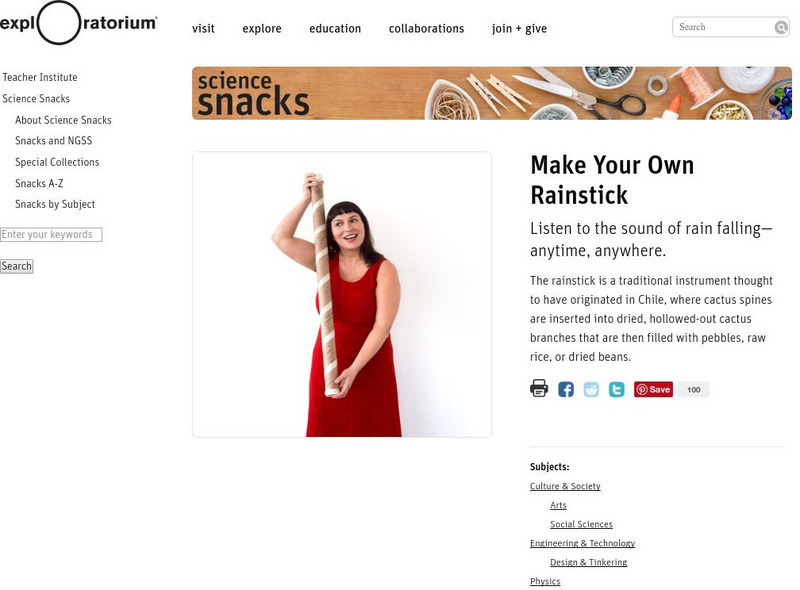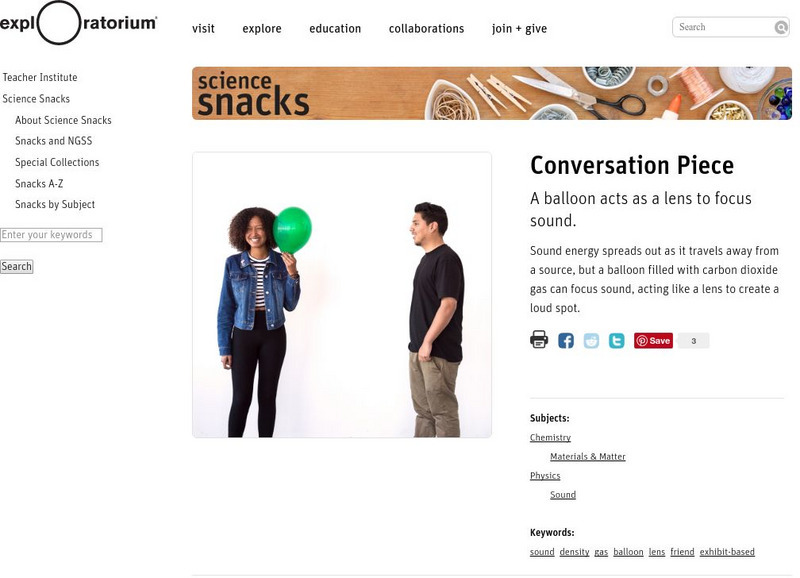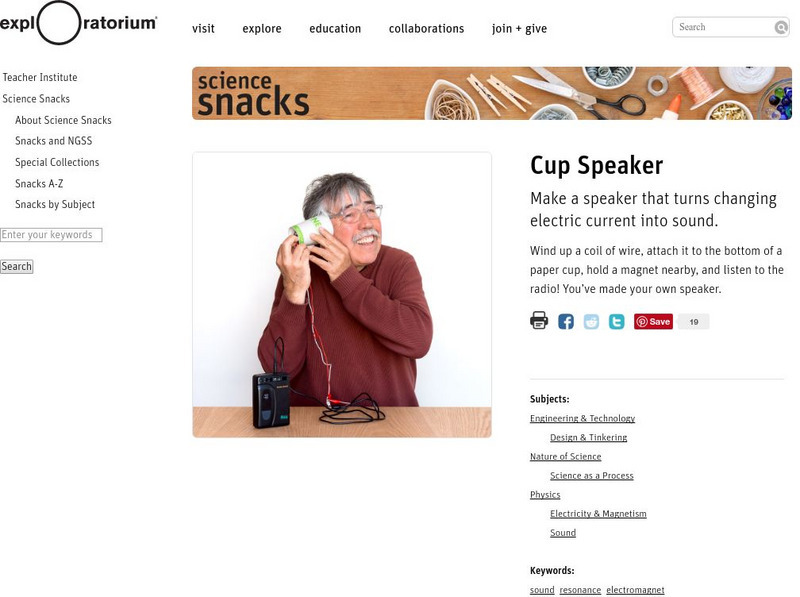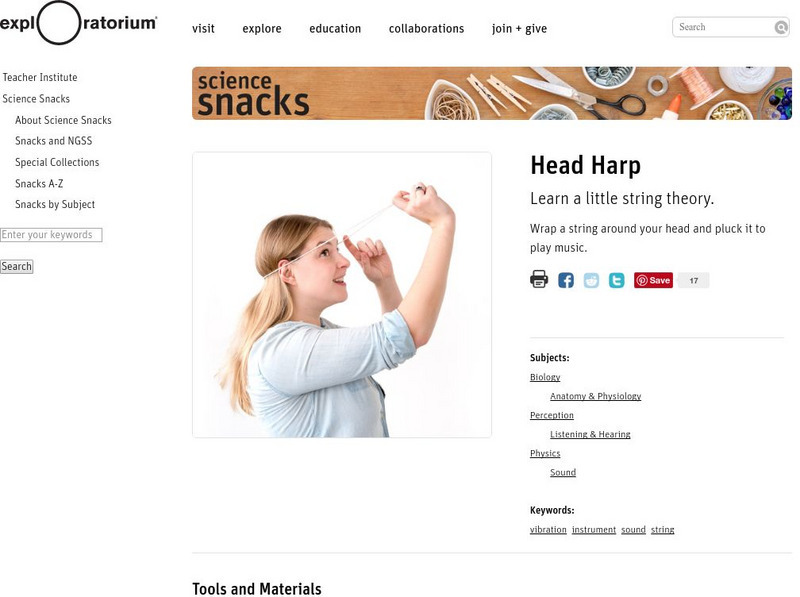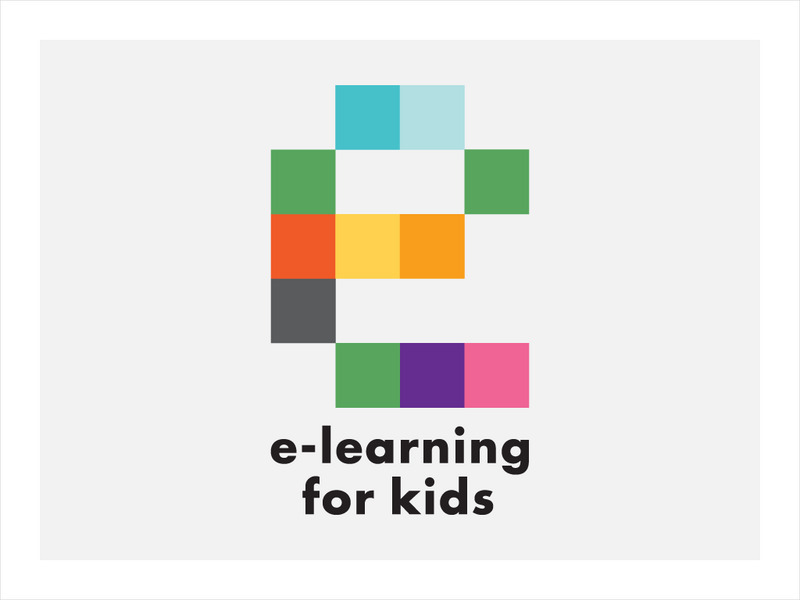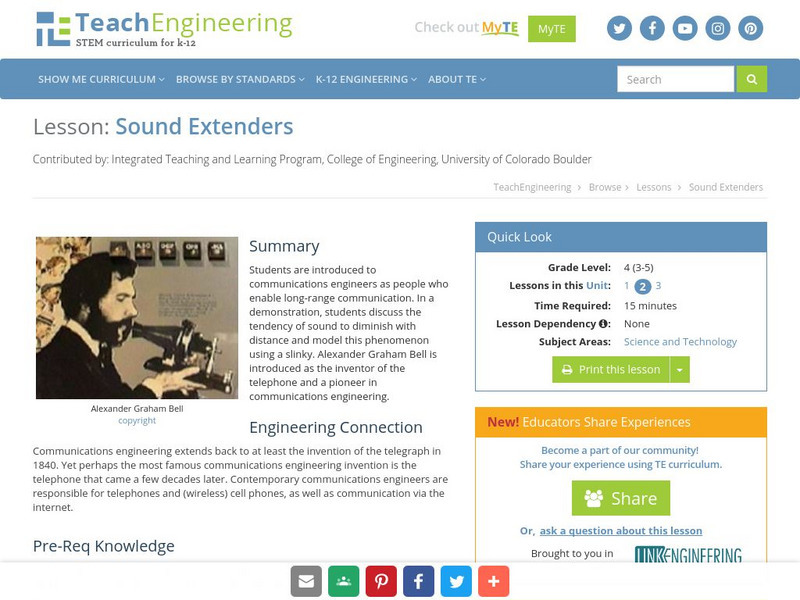National High Magnetic Field Laboratory
Magnet Academy: Barkhausen Effect
The Barkhausen effect makes the concept of magnetic domains audible (if not exactly music to the ear).
Exploratorium
Exploratorium: Science Snacks: Make Your Own Rainstick
Create a traditional instrument called a rainstick in this activity.
Exploratorium
Exploratorium: Science Snacks: Stereo Sound
Try this experiment to understand how your ears are able to locate where a sound is coming from.
E-learning for Kids
E Learning for Kids: Science: Pirates: What Is Sound?
In this lesson, students learn about sound vibrations, pitch, how frequency is measured, and about the recommended upper decibel limit of noise.
E-learning for Kids
E Learning for Kids: Science: Seychelles: How Do We Hear?
This lesson teaches students about how sound vibrations are transmitted through solids, liquids, and gases, and about how materials may absorb sound.
E-learning for Kids
E Learning for Kids: Science: Antarctica: Which Types of Sounds Do You Know?
For this lesson, students learn about the five senses, identify objects that make sound, and take a fun fact quiz at the end.
Exploratorium
Exploratorium: Science Snacks: Bee Hummer
An engineering design project to use simple materials to make an instrument to mimic the sound of a swarm of bees.
Exploratorium
Exploratorium: Science Snacks: Coffee Can Cuica
In this activity students will use the engineering design process to make a musical instrument called a cuica. This musical instrument uses "stick-and-slip" vibrations to make the sound.
Exploratorium
Exploratorium: Science Snacks: Conversation Piece
Did you know a balloon filled with carbon dioxide can act as an amplifier? In this activity test how sound travels through carbon dioxide molecules.
Exploratorium
Exploratorium: Science Snacks: Cup Speaker
This activity will have students creating their own speaker with a paper cup, coil of wire, and magnet. The speaker operates by changing electric current into sound.
Exploratorium
Exploratorium: Science Snacks: Doppler Effect
Learn about how the Doppler effect explains the change in pitch as a sound source moves in relation to you with this activity. This activity has the students making their own Doppler ball.
Exploratorium
Exploratorium: Science Snacks: Falling Rhythm
An engineering design process project for students to create a regular rhythm of beats by spacing weights along a string and then dropping the string.
Exploratorium
Exploratorium: Science Snacks: Groovy Sounds
Using a paper, pencil, and pin students will build a phonograph in this activity. Students will be able to listen to their favorite record with this homemade record player.
Exploratorium
Exploratorium: Science Snacks: Head Harp
Want to make music with your head? In this experiment, create a musical instrument by wrapping a string around your head.
E-learning for Kids
E Learning for Kids: Antarctica Fishing Boat: Where Do Sounds Come From?
In this lesson, students explore where sounds come from and the different sounds that animals make.
TeachEngineering
Teach Engineering: Pitch and Frequency
To further their understanding of sound energy, students identify the different pitches and frequencies created by a vibrating ruler and a straw kazoo. They create high- and low-pitch sound waves.
TeachEngineering
Teach Engineering: Sound Line
Students learn the decibel reading of various noises and why high-level readings damage hearing. Sound types and decibel readings are written on sheets of paper, and students arrange the sounds from the lowest to highest decibel levels....
TeachEngineering
Teach Engineering: Sound Extenders
In this lesson, young scholars are introduced to communications engineers as people who enable long-range communication. In the lesson demonstration, students discuss the tendency of sound to diminish with distance and model this...
TeachEngineering
Teach Engineering: Sound Environment Shapers
In this lesson plan, students are introduced to the sound environment as an important aspect of a room or building. Several examples of acoustical engineering design for varied environments are presented to students. Students learn the...
Scholastic
Scholastic Instructor: Science of Sound
This resource is for teachers who are looking for information, activities, experiments, and more pertaining to the science of sound.
Physics Classroom
The Physics Classroom: Sound Properties and Their Perception
The concept of pitch and frequency is covered in this tutorial. Learn what frequency and pitch are, the difference between infra sound and ultrasonic frequencies, and how pitch is related to the frequency of a sound.
Read Works
Read Works: A Loud Concert
[Free Registration/Login Required] Sound waves are discussed in this realistic fiction article. This passage is a stand-alone curricular piece that reinforces essential reading skills and strategies and establishes scaffolding for...
CK-12 Foundation
Ck 12: Physical Science: Hearing and the Ear
[Free Registration/Login may be required to access all resource tools.] Explains how we hear sound, how the ear works, and the different structures of the ear.
CK-12 Foundation
Ck 12: Physical Science: Energy
[Free Registration/Login may be required to access all resource tools.] Discusses the definition of energy, the SI unit, and the seven different forms of energy.



